ChemComm is delighted to invite nominations for the very first ChemComm Emerging Investigator Lectureship. The lectureship, which will be awarded annually, will recognise an emerging scientist in the early stages of their independent academic career. Deadline for nominations: 28th February 2011. Visit the ChemComm blog for more information.
HOT Article: Unexpected hydrogen-bonding
In this CrystEngComm Hot article, Alicia Beatty and coworkers from the University of Missouri have discovered that sterically demanding groups cause different hydrogen-bonding connectivity in certain lamellar solids. The group looked at 3,5-pyrazole dicarboxylic acid and various amines and explored how this effected the packing of the co-crystals.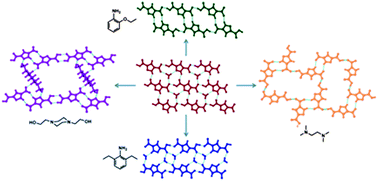
Exceptions to the rule: new hydrogen-bonded networks from an old reliable
Onome Ugono, Nigam P. Rath and Alicia M. Beatty
CrystEngComm, 2010, Advance Article
DOI: 10.1039/C0CE00621A, Communication
FREE TO READ until 1st December
HOT Article: Magnetic changes in low dimensional spin systems
This CrystEngComm Hot article looks at the changes in the magnetic behaviour of Cu(II)-p-hydroquinoanate polymers that occur with structural modification and the loss of DMF ligands. These findings could lead to a new way of preparing novel spin lattices, adding a new tool to the crystal engineers toolbox.
Thermally induced crystal-to-crystal transformations accompanied by changes in the magnetic properties of a CuII-p-hydroquinonate polymer
Ngoc Hien Phan, Ivan Halasz, Ingo Opahle, Edith Alig, Lothar Fink, Jan W. Bats, Pham Thanh Cong, Hans-Wolfram Lerner, Biprajit Sarkar, Bernd Wolf, Harald O. Jeschke, Michael Lang, Roser Valentí, Robert Dinnebier and Matthias Wagner
CrystEngComm, 2011, Advance Article
DOI: 10.1039/C0CE00367K, Communication
FREE TO READ until 1st December 2010
HOT Article: achiral MOFs?
The formation of a near achiral metal-organic framework from the self assembly of chiral building blocks is investigated in this CrystEngComm Hot article.
Near achiral metal–organic frameworks from conformationally flexible homochiral ligands resulted by the preferential formation of pseudo-inversion center in asymmetric unit
Kyung Seok Jeong, Bo Hyung Lee, Qiaowei Li, Sang Beom Choi, Jaheon Kim and Nakcheol Jeong
CrystEngComm, 2011, Advance Article
DOI: 10.1039/C0CE00426J, Communication
READ FOR FREE until 1st December 2010
Defining the Halogen Bond – IUPAC task group need your input!
CrystEngComm authors Pierangelo Metrangolo and Giuseppe Resnati are chairing an IUPAC task group looking at the classification of halogen bonds.
The task group’s objective is to give a modern definition of halogen bonding, which takes into account all current experimental and theoretical pieces of information on both gaseous and condensed halogen-bonded systems in chemical and biological systems.
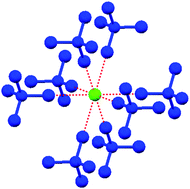 The group intend the whole community of researchers dealing with the study and use of intermolecular interactions to be involved in this Project. A dedicated web-site has been set-up as a public discussion forum for consideration of public comments. The Project will be featured in major meetings relevant to related fields, in particular at the XXII General Assembly and Congress of the International Union of Crystallography (IUCr) to be held in Madrid, Spain, in 22–29 August 2011. In the second year of the Project, an international symposium open to the public will be organized, for consideration of public comments, presentation, and dissemination of results.
The group intend the whole community of researchers dealing with the study and use of intermolecular interactions to be involved in this Project. A dedicated web-site has been set-up as a public discussion forum for consideration of public comments. The Project will be featured in major meetings relevant to related fields, in particular at the XXII General Assembly and Congress of the International Union of Crystallography (IUCr) to be held in Madrid, Spain, in 22–29 August 2011. In the second year of the Project, an international symposium open to the public will be organized, for consideration of public comments, presentation, and dissemination of results.
Just before the IUCr Madrid Congress, and a satellite event to it, an international workshop open to the public will be organized in Sigüenza, Guadalajara (August 20-21), for consideration of public comments, presentation, and dissemination of results. For more info contact the scientific secretariat serena.biella@polimi.it or gabriella.cavallo@polimi.it.
The group membership includes Professor Gautam Desiraju (Bangalore, India), founding Editorial Board member, and current Advisory Board member of CrystEngComm and Kari Rissanen (Jyväskylä, Finland), former Advisory Board member of CrystEngComm.
The task group need your input and so we invite you post a comment below to join the discussion and give us your opinion on the definition of a halogen bond.
Follow the links below to read CrystEngComm Highlights with a focus on halogen bonding:
Halogen bonded supramolecular complexes and networks
Kari Rissanen
CrystEngComm, 2008, 10, 1107-1113 DOI: 10.1039/B803329N
Combining metals with halogen bonds
Lee Brammer, Guillermo Mínguez Espallargas and Stefano Libri
CrystEngComm, 2008, 10, 1712-1727
Anion coordination and anion-templated assembly under halogen bonding control
Pierangelo Metrangolo, Tullio Pilati, Giancarlo Terraneo, Serena Biella and Giuseppe Resnati
CrystEngComm, 2009, 11, 1187-1196 DOI: 10.1039/B821300C
Or read a recent CrystEngComm interview with Task Group Chair Pierangelo Metrangolo here.
November Crystal Clear: Nanoflower power
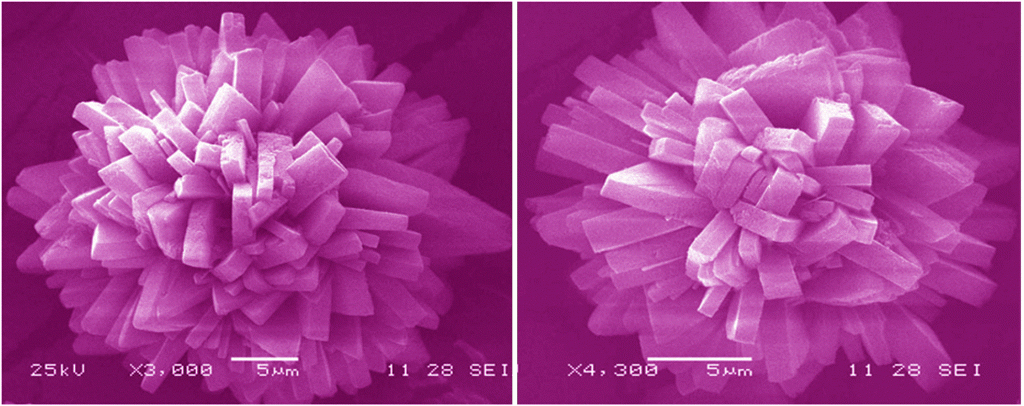 This month’s Crystal Clear is an eye-catching flower-like crystal. It’s nano size doesn’t stop it from rivalling nature’s chrysanthemums! The flowers are made from hexahedronal petals of (Ni3(PO4)2·8H2O) obtained from a simple template-free hydrothermal route.
This month’s Crystal Clear is an eye-catching flower-like crystal. It’s nano size doesn’t stop it from rivalling nature’s chrysanthemums! The flowers are made from hexahedronal petals of (Ni3(PO4)2·8H2O) obtained from a simple template-free hydrothermal route.
The striking image is taken from an article in Issue 12 by Huaming Li and coworkers (Xiangtan University, China):
READ FOR FREE until the 30th of November
Controlled synthesis of nickel phosphate hexahedronal and flower-like architectures via a simple template-free hydrothermal route
Journal Article
Hui Wu, Yong Gao and Huaming Li
CrystEngComm, 2010, 12, 3607-3611
DOI: 10.1039/C002120B , Paper
Interview: Keiichiro Ogawa talks to CrystEngComm
Keiichiro Ogawa is a professor of chemistry at the Graduate School of Arts and Sciences, University of Tokyo, Japan. His research is aimed at the understanding and control of the dynamic behaviour of organic compounds and other molecular assemblies in crystals. Keiichiro was awarded the Crystallographic Society Japan Award in 1997 and recently a Chemical Society of Japan Contribution Award in 2007. He is a member of the CrystEngComm Advisory Board.
Why did you to become a scientist?
Having grown up in a family of three generations of scientists, I have wanted to be a scientist since boyhood. In particular, I was intrigued by science because it unravels the mysteries of the universe, and leads to technologies that contribute to our wellbeing.
What projects are you working on at the moment?
My group is working on solid-state reactions in organic crystals, particularly those related with color-changing phenomena, i.e., photochromism and thermochromism.
What do you think will be the next big breakthrough in your field?
Such a prediction is difficult but it will probably be the emergence of completely new methods for measuring these phenomena. If this happens it could provide totally a new insights into the world of matter, as brought about by the arrival of the analytical techniques in X-ray crystallography and NMR spectroscopy.
How do you think crystal engineering will develop in the next five years?
As methodologies for detection of minor products are refined, organic solid state reaction mechanisms should become better understood. This will give us much a more comprehensive picture of what happens in a sequence of solid-state reactions.
What is the most rewarding aspect of your work?
The excitement of presenting new findings and/or interpretations to an appreciative and expert audience!
Good people and good projects are the most essential components for successful scientific research. I’ve been fortunate in having an excellent research colleague, very good students and some challenging research topics.
What achievement are you most proud of?
I am particularly proud at having found that an apparent shortening of the central bond of stilbene-type molecules is caused by the torsional vibrations in crystals (K. Ogawa et al., JACS, 1992, 114, 1041). This finding led to the discovery of a more prominent molecular motion, i.e., pedal motion in crystals (J. Harada and K. Ogawa, Chem. Soc. Rev., 2009, 38, 2244.).
Young scientists must understand their principal research topic as deeply as possible, while being aware of the broader thrust of the field. The wider view can often provide insights into the subject you are most interested in.
What would you do if you weren’t a scientist?
My hobby is opera singing and my dream would be to be a professional singer, though I know I don’t have sufficient talent to start this career. Music can move one’s heart instantly, even within a second. Science can also do this, though not so quickly as in music. The important thing for me is that they both give joy.
What is your favourite place to be?
If I must live and work in one place, it would definitely be Tokyo. I have lived in Tokyo since my birth and I find it a vibrant, safe, and beautiful city. I like to visit other places, particularly in foreign countries, but I always enjoy returning home.
More about Keiichiro on his webpage at the University of Tokyo.
Read some of Keiichiro’s research in the following CrystEngComm articles:
Crystalline-state conformational change of β-nitrostyrenes and its freezing at low temperature
Jun Harada, Mayuko Harakawa and Keiichiro Ogawa
CrystEngComm, 2009, 11, 638-642 DOI: 10.1039/B815869J
Single crystal cis–trans photoisomerizations of 2-(9-anthrylmethylene)-1-indanones
Jun Harada, Mayuko Harakawa, Shingo Sugiyama and Keiichiro Ogawa
CrystEngComm, 2009, 11, 1235-1239 DOI: 10.1039/B821900A
Conformational change of all-trans-1,6-diphenyl-1,3,5-hexatriene in two crystalline forms
Jun Harada, Mayuko Harakawa and Keiichiro Ogawa
CrystEngComm, 2008, 10, 1777-1781 DOI: 10.1039/B811220G
Hot Article: Arty silca-coated nanocrystals
Ping Yang and co-workers from the University of Jinan, China have created SiO2-coated CdTe nanocrystal using
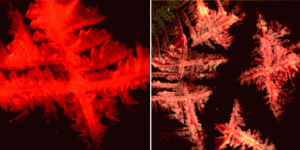
Ping Yang, Zhimin Yuan, Jie Yang, Aiyu Zhang, Yongqiang Cao, Qinghui Jiang, Ruixia Shi, Futian Liu and Xin Cheng
CrystEngComm, 2011, DOI: 10.1039/C0CE00350F
READ FOR FREE! Until November 25th.
HOT Article: A crystalline gas?
In this CrystEngComm Hot Article, Andrzej Katrusiak and colleagues discuss the isobaric freezing of 1,1,1-trichloroethane to yields crystals. These crystals could shed new light on the range of intermolecular interactions that are capable of controlling molecular re-orientation and arrangement.
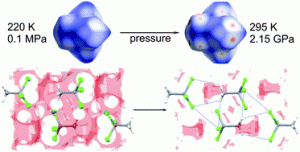
Crystalline gas of 1,1,1-trichloroethane
Maciej Bujak, Marcin Podsiadło and Andrzej Katrusiak
CrystEngComm, 2011,DOI: 10.1039/C0CE00493F
READ FOR FREE! Until 25th November.
This week’s CrystEngSelects
Here is this week’s selection of advanced articles of interest to crystal engineers from across the RSC journals.
 |
Articles are chosen from: ChemComm, CrystEngComm, Dalton Transactions, Journal of Materials Chemistry, New Journal of Chemistry, Nanoscale, Organic & Biomolecular Chemistry. |
DOI: 10.1039/C0CC02550J, Communication
DOI: 10.1039/C0CE00153H, Paper
DOI: 10.1039/C0DT00708K, Perspective
DOI: 10.1039/C0CE00350F, Paper
DOI: 10.1039/C0CE00281J, Paper
DOI: 10.1039/C0CE00168F, Paper
DOI: 10.1039/C0CE00340A, Paper
DOI: 10.1039/C0CE00271B, Paper
DOI: 10.1039/C004371K, Paper
DOI: 10.1039/C0CE00382D, Paper
DOI: 10.1039/C0CC03485A, Communication
DOI: 10.1039/C0CE00553C, Communication
DOI: 10.1039/C0JM03004J, Communication
DOI: 10.1039/C0CE00493F, Communication
DOI: 10.1039/C0CE00507J, Communication
DOI: 10.1039/C0CE00315H, Paper
DOI: 10.1039/C0DT01064B, Paper
DOI: 10.1039/C0CE00170H, Paper
DOI: 10.1039/C0JM02355H, Paper
DOI: 10.1039/C0CE00143K, Paper
DOI: 10.1039/C0DT00709A, Paper
DOI: 10.1039/C0CE00330A, Paper
DOI: 10.1039/C0JM02174A, Paper
DOI: 10.1039/C0JM02446E, Paper
DOI: 10.1039/C0CE00388C, Paper













